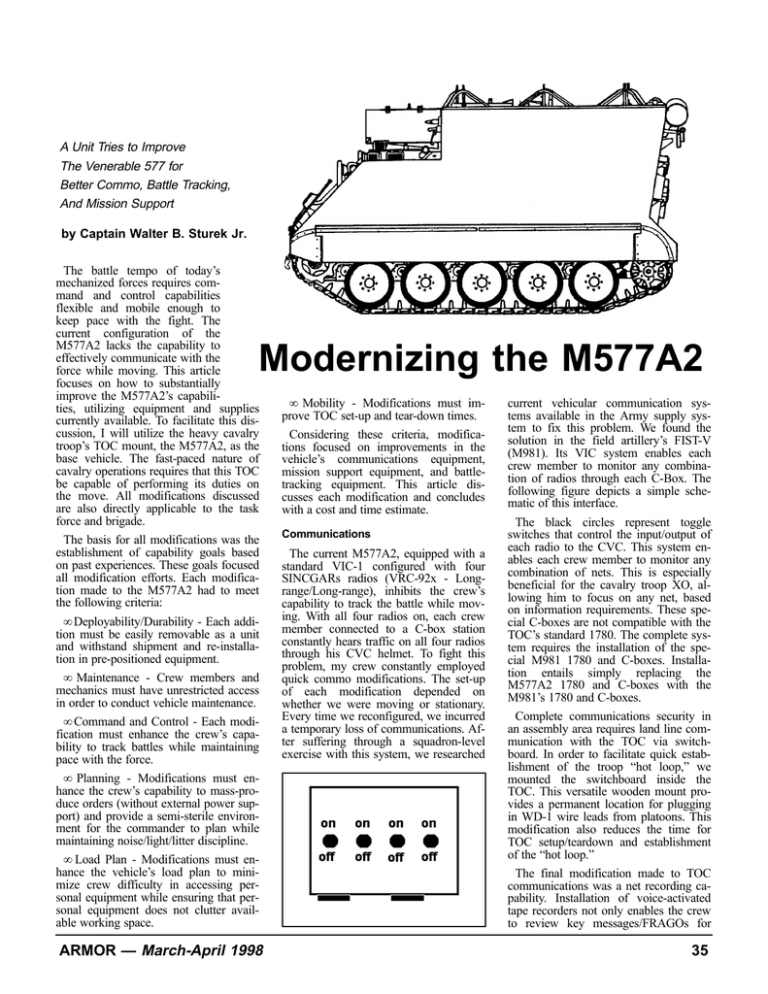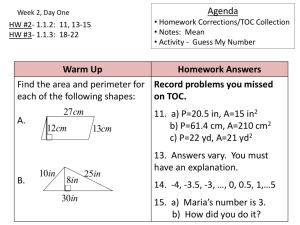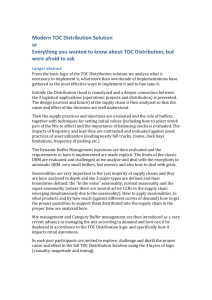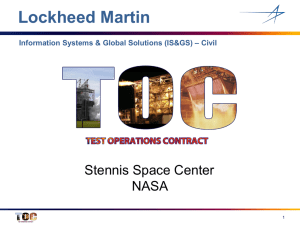The battle tempo of today’s mechanized forces requires com-
advertisement

A Unit Tries to Improve The Venerable 577 for Better Commo, Battle Tracking, And Mission Support by Captain Walter B. Sturek Jr. The battle tempo of today’s mechanized forces requires command and control capabilities flexible and mobile enough to keep pace with the fight. The current configuration of the M577A2 lacks the capability to effectively communicate with the force while moving. This article focuses on how to substantially improve the M577A2’s capabilities, utilizing equipment and supplies currently available. To facilitate this discussion, I will utilize the heavy cavalry troop’s TOC mount, the M577A2, as the base vehicle. The fast-paced nature of cavalry operations requires that this TOC be capable of performing its duties on the move. All modifications discussed are also directly applicable to the task force and brigade. The basis for all modifications was the establishment of capability goals based on past experiences. These goals focused all modification efforts. Each modification made to the M577A2 had to meet the following criteria: • Deployability/Durability - Each addition must be easily removable as a unit and withstand shipment and re-installation in pre-positioned equipment. • Maintenance - Crew members and mechanics must have unrestricted access in order to conduct vehicle maintenance. • Command and Control - Each modification must enhance the crew’s capability to track battles while maintaining pace with the force. • Planning - Modifications must enhance the crew’s capability to mass-produce orders (without external power support) and provide a semi-sterile environment for the commander to plan while maintaining noise/light/litter discipline. • Load Plan - Modifications must enhance the vehicle’s load plan to minimize crew difficulty in accessing personal equipment while ensuring that personal equipment does not clutter available working space. Modernizing the M577A2 ARMOR — March-April 1998 • Mobility - Modifications must improve TOC set-up and tear-down times. Considering these criteria, modifications focused on improvements in the vehicle’s communications equipment, mission support equipment, and battletracking equipment. This article discusses each modification and concludes with a cost and time estimate. Communications The current M577A2, equipped with a standard VIC-1 configured with four SINCGARs radios (VRC-92x - Longrange/Long-range), inhibits the crew’s capability to track the battle while moving. With all four radios on, each crew member connected to a C-box station constantly hears traffic on all four radios through his CVC helmet. To fight this problem, my crew constantly employed quick commo modifications. The set-up of each modification depended on whether we were moving or stationary. Every time we reconfigured, we incurred a temporary loss of communications. After suffering through a squadron-level exercise with this system, we researched current vehicular communication systems available in the Army supply system to fix this problem. We found the solution in the field artillery’s FIST-V (M981). Its VIC system enables each crew member to monitor any combination of radios through each C-Box. The following figure depicts a simple schematic of this interface. The black circles represent toggle switches that control the input/output of each radio to the CVC. This system enables each crew member to monitor any combination of nets. This is especially beneficial for the cavalry troop XO, allowing him to focus on any net, based on information requirements. These special C-boxes are not compatible with the TOC’s standard 1780. The complete system requires the installation of the special M981 1780 and C-boxes. Installation entails simply replacing the M577A2 1780 and C-boxes with the M981’s 1780 and C-boxes. Complete communications security in an assembly area requires land line communication with the TOC via switchboard. In order to facilitate quick establishment of the troop “hot loop,” we mounted the switchboard inside the TOC. This versatile wooden mount provides a permanent location for plugging in WD-1 wire leads from platoons. This modification also reduces the time for TOC setup/teardown and establishment of the “hot loop.” The final modification made to TOC communications was a net recording capability. Installation of voice-activated tape recorders not only enables the crew to review key messages/FRAGOs for 35 LIGHTS Coffin Bench Sets in center of the TOC on the floor, bolted into the floor VA 1523 15" VA TAPE RECORDER 1523 1523 1523 C-BOX C-BOX SENSITIVE ITEMS 1780 15" FMs, TMs, DA FORMS 22.5" REAR FRONT REPORT REPORT REPORT REPORT REPORT SWITCHBOARD 18" 60" 54" Figure 2. Coffin Bench TOC LEFT SIDE WALL Figure 3. TOC Left Side Wall LIGHTS INVERTER 38" MAP BOARD & CLASS II STORAGE AREA C-BOX FRONT REAR BOX - 53" MAP BOARD - 75" BATTERIES Figure 4. TOC Right Side Wall TOC RIGHT SIDE WALL SIDE VIEW FRONT VIEW 12" 22" 36" WOOD SCREWS 38" 4" 24" 75" 53" Figure 5. Map Board 36 MAP BOARD/CLASS II STORAGE BOX DIMENSIONS ARMOR — March-April 1998 Cost Estimate “The modifications discussed enhance the capabilities of the M577A2 to perform its mission as a tactical operations center.” clarification but also facilitates AARs. In order to eliminate background noise from within the TOC, the recorders must directly interface with the radio mount. To do this, splice the microphone cord from the tape recorder with a connector of an old hand mike, and then plug the hand mike connector into either the speaker connector of the radio mount or directly to the RT. Mission Support Equipment Mission support equipment modifications modernized the TOC’s planning process and decreased the time for producing an OPORD. Current TOC configurations utilize the SICUP extension with AC-powered fluorescent lights. Powering these lights poses no problem for the battalion task force or brigade equipped with generators. Organic power provided by the M577A2 only powers DC equipment. The solution to this problem was the purchase and installation of a power inverter. The power inverter we installed was a 24-volt system producing 1800 watts. A 24-volt inverter reaps the benefits of the M577A2’s 24-volt system and has easily replaceable 40 amp automotive fuses. This amount of power facilitates the use of a laptop computer with printer, as well as a copier, without requiring external power assets. The laptop computer and printer provides the commander an interface for filling in a shell troop OPORD format and produces a legible hard copy order. The copier machine enables the TOC to mass-produce hardcopy OPORDs for issue. The copier machine also proved invaluable in copying small overlays (81⁄2 x 11) produced by the commander. The commander’s HMMWV solves temporary storage problems by transporting the copier when the TOC is on the move. Internal modifications to the M577A2 consist of a new map board, book shelf, and storage box (coffin). The internal map board mounts on the right wall and shelf of the TOC. Hinged at the top, this map board installs as a complete unit with approximately seven screws and provides internal storage space for supplies and BII. Its design facilitates easy access to the TOC’s battery compartment ARMOR — March-April 1998 > Amplifier, Audio frequency (1780) - NSN 01-144-5970 > Cable, Splitter - x 4 - NSN 01-348-2264 > Control Intercom Unit (Charlie Box) x 4 - NSN 01-144-5995 > Inverter > Copier Machine w/Toner > Plywood (2) 4x8 sheets > Wood (3) 2x4 > Cork Board > Voice activated Tape Recorders x 4 > Total cost for (1) Troop/Company TOC = $4,045 $1,156 $9,756 $ 724 $ 820 $ 50 $ 10 $ 24 $ 160 $16,745 while mounted. Its ease of installation/removal makes it easily deployable. The map board’s large surface area for maps, and its angled front, allows the user (especially the commander in the planning Figure 6. Cost Estimate process) to modify tainable through local purchase. Figure 6 graphics. The angled map board accomdetails the costs. plishes this by providing a user-friendly slightly horizontal surface. Glued to the Although somewhat costly, the commap board underneath the map are munication modifications comprise the 12"x12" cork panels. The cork facilitates most critical enhancements to the the use of colored pushpins for tracking M577A2. Most units fielding the new unit/vehicle locations. Mounted on the VIC-3 system are only fielding it with left sidewall is a bookshelf for storage of the M1A1 tank and M2 Bradley. The FMs/TMs and supplies. Finally, the M981 VIC system is available now (CL crew’s gear mounts on the sides of the IX). Local purchase items include the TOC by attaching two steel cables (ramp copier machine, tape recorders, inverter, tiedown cable for rail-loading) along and cork boards. Plywood and 2x4s are both sides of the vehicle. Mounting the available on most installations. It takes crew’s gear in this fashion eases access approximately 20 hours for complete to TA-50 and frees space on top of the construction/installation of all modificavehicle for stowage of the extension and tions (2-3 hours for the commo system, other equipment. 17 hours for the map board and bookshelf). Removal of the bookshelf/map Tracking the Battle board takes approximately 15 minutes. The modifications discussed enhance The modifications discussed enhance the crew’s ability to track the battle the capabilities of the M577A2 to perwhile maintaining pace with the troop. form its mission as a tactical operations Even with these modifications, battle center. Although focused at the cavalry tracking in the M577A2 requires a sound troop TOC, the criterion of deployability, SOP and a well-trained cohesive crew. ease of maintenance, durability, and Effective battle tracking during offensive communication enhancement applies to and defensive operations requires a fourboth battalion- and brigade-level TOCs. man crew consisting of a dedicated Offensive operations require a mobile driver with three RTOs: troop XO (moniand efficient command and control node. tors troop and squadron command), NBC The modifications discussed above transNCO (monitors O&I), and the commo form the standard M577A2 into this eschief (monitors A&L). In order to minisential platform. mize internal vehicular noise during halts, the commander’s HMMWV slaves to the TOC. This minimizes internal noise for the RTOs and eliminates the CPT Walter B. Sturek Jr. is a 1993 need to start the vehicle for battery graduate of the the United States Military charging. When the commander’s Academy. He has served as a tank plaHMMWV is available during the plantoon leader, scout platoon leader, and ning process, this technique also elimicavalry troop executive officer in 3/3 nates the need to utilize the M577A2’s ACR. Key personnel in development of noisy generator and engine. these modifications were CPT Richard D. Cost Analysis All modifications discussed are available through the supply system or ob- Moon, 1LT Ernest Litynski, SSG Mark Kastner, SPC Daniel Sumners, PFC Marotz, CPT Neil Corson, and SFC Lawrence Eversole. 37






